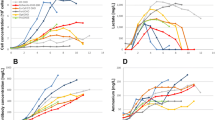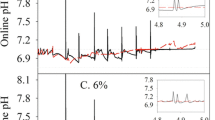Abstract
Batch and fed-batch cultures of a murine hybridomacell line (AFP-27) were performed in a stirred tankreactor to estimate the effect of feed rate on growthrate, macromolecular metabolism and antibodyproduction. Macromolecular composition was foundto change dynamically during batch culture ofhybridoma cells possibly due to active production ofDNA, RNA and protein during the exponential phase.Antibody synthesis is expected to compete with theproduction of cellular proteins from the amino acidpool. Therefore, it is necessary to examine therelationship between cell growth in terms of cellularmacromolecules and antibody production. In this study,we searched for an optimum feeding strategy bychanging the target specific growth rate in fed-batchculture to give higher antibody productivity whileexamining the macromolecular composition. Concentratedglucose (60 mM) and glutamine (20 mM) in DR medium(1:1 mixture of DMEM and RPMI) with additional aminoacids were fed continuously to the culture and thefeed rate was updated after every sampling to ensureexponential feeding (or approximately constantspecific growth rate). Specific antibody productionrate was found to be significantly increased in thefed-batch cultures at the near-zero specific growthrate in which the productions of cellular DNA, RNA,protein and polysaccharide were strictly limited byslow feeding of glucose, glutamine and other nutrients. Possible implications of these results are discussed.
Similar content being viewed by others
References
Al-Rubeai M, Oh SKW, Musaheb R & Emery AN (1990) Modified cellular metabolism in hybridomas subjected to hydrodynamic and other stresses. Biotechnol Lett 12: 323-328.
Barford JP, Phillips PJ, Marquis CP & Harbour C (1996) Biosynthesis of protein products by animal cells. Are growth and non-growth associated concepts valid or useful? Cytotechnology 21: 133-148.
Bibila TA & Robinson DK (1995) In pursuit of the optimal fedbatch process for monoclonal antibody production. Biotech Prog 11: 1-13.
Bonarius HPJ, Hatzumanikatis V, Meesters KPH, de Gooijer CD, Schmid G & Tramper J (1996) Metabolic flux analysis of hybridoma cells in different culture media using mass balances. Biotechnol Bioeng 50: 299-318.
Boraston R, Thompson PW, Garland S & Birch JR (1984) Growth and oxygen requirements of antibody-producing mouse hybridoma cells in suspension culture. Devel Biol Stand 55: 103-111.
Bradford MM (1976) A rapid sensitive method for the quantification of microgram quantities of protein utilizing the principle of protein dye binding. Anal Biochem 72: 248-254.
Brown AH (1946) Determination of pentose in the presence of large quantities of glucose. Arch Biochem 11: 269-278.
Bushell ME, Bell SL, Scott MF, Spier RE, Wardell JN & Sanders PG (1994) Enhancement of monoclonal antibody yield by hybridoma fed-batch culture, resulting in extended maintenance of viable cell population. Biotechnol Bioeng 44: 1099-1106.
Dische Z (1955) Color reactions of nucleic acid components. In: Chargaff E & Davison JN (eds) Nucleic Acids, Vol. 1 (p. 287) Academic Press, New York.
Dubois M, Gilles KA, Hamilton JK, Rebers PA & Smith F (1956) Colorimetric method for determination of sugars and related substances. Anal Chem 28: 350-356.
Fermo I, Ruboni FM, Bolzacchini E, Arcelloni C & Bonini PA (1988) Pre-column derivatization of amino acids with N,N,-diethyl-2,4-dinitro-5-fluoroaniline and reversed-phase liquid chromatographic separation. J Chromatogr 433: 53-62.
Fermo I & Vecchi ED (1990) Serum amino acid analysis with pre-column derivatization: comparison of the o-phthaldialdehyde and N,N,-diethyl-2,4-dinitro-5-fluoroaniline method. J Chromatogr 534: 23-25.
Folch JL & Sloane SG (1957) A simple method for the isolation and purification of total lipids from animal tissues. J Biol Chem 226: 97-509.
Frame KK & Hu W-S (1991) Kinetic study of hybridoma cell growth in continuous culture. I. A model for non-producing cells. Biotechnol Bioeng 37: 55-64.
Garatun-Tjeldstø O, Pryme IF, Weltman JK & Dowben RM (1976) Synthesis and secretion of light-chain immunoglobulin in two successive cycles of synchronized plasmacytoma cells. J Cell Biol 68: 232-239.
Glacken MW, Fleischaker RJ & Sinsky AJ (1986) Reduction of waste product excretion via nutrient control: Possible strategies for maximizing product and cell yields on serum in cultures of mammalian cells. Biotechnol Bioeng 28: 1376-1389.
Golding B, Pillemer SR, Roussou P, Peter EA, Tsokos GC, Ballow JE & Hoffman T (1988) Inverse relationship between proliferation and differentiation in a Human TNP-specific B cell line. Cell cycle dependence of antibody secretion. J Immunol 131: 2564-2568.
Halliburton IW & Thompson RY (1965) Chemical aspects of compensatory renal hypertrophy. Cancer Res 25: 1882-1887.
Hayter PM, Kirkby NF & Spier RE (1992) Relationship between hybridoma growth and monoclonal antibody production. Enzyme Microb Technol 14: 454-461.
King KL & Cidlowski JA (1998) Cell cycle regulation and apoptosis. Ann Rev Physiol 60: 601-617.
Köhler G & Milstein C (1975) Continuous cultures of fused cells secreting antibody of predefined specificity. Nature 256: 495-497.
Leno M, Merten O-W & Hache J (1992) Kinetic analysis of hybridoma growth and monoclonal antibody production in semicontinuous culture. Biotechnol Bioeng 39: 596-606.
Linardos TI, Kalogerakis N & Behie LA (1992) Cell cycle model for growth rate and death rate in continuous suspension hybridoma cultures. Biotechnol Bioeng 40: 359-368.
Ljunggren J & Häggström L (1994) Catabolic control of hybridoma cells by glucose and glutamine limited fed batch culture. Biotechnol Bioeng 44: 808-818.
Merlo GR, Fiore L, Basolo F, Woods-Cook K & Hynes NE (1997) In mammary epithelial cells p53-mediated apoptosis in response to DNA damage is dependent on the agent and can be influenced by growth factors. Endoc Rel Cancer 4: 55-66.
Miller WM, Blanch HW & Wilke CR (1988) A kinetic analysis of hybridoma growth and metabolism in batch and continuous suspension culture: Effect of nutrient concentration, dilution rate, and pH. Biotechnol Bioeng 32: 947-965.
Newland M, Kamal MN, Greenfield PF & Nielsen LK (1994) Ammonia inhibition of hybridomas propagated in batch, fed-batch, and continuous culture. Biotechnol Bioeng 43: 434-438.
Nielsen LK, Niloperbowo W, Reid S & Greenfield PF (1992) Avoiding rapid growth at high cell densities: A potentially important optimization criterion for hybridoma cultures. Cytotechnology 9: 21-27.
Pentz M & Shott M (1989) Handling Experimental Data. Open University Press, Milton Keynes, U.K.
Phillips PJ, Marquis CP, Barford JP & Harbour C (1991) An analysis of some batch and continuous kinetic data of specific monoclonal antibody production from hybridomas. Cytotechnology 6: 189-195.
Pirt SJ (1957) Principles of microbe and cell cultivation. John Wiley & Sons, New York.
Pörtner R & Schäfer T (1996) Modeling hybridoma cell growth and metabolism-a comparison of selected models and data. J Biotechnol 49: 119-135.
Ramírez OT & Mutharasan R (1990) Cell cycle-and growth phasedependent variations in size distribution, antibody productivity, and oxygen demand in hybridoma cultures. Biotechnol Bioeng 36: 839-848.
Ray NG, Karkare SB & Runstadler Jr, PW (1989) Cultivation of hybridoma cells in continuous cultures: Kinetics of growth and product formation. Biotechnol Bioeng 33: 724-730.
Robinson DK & Memmert KW (1991) Kinetics of recombinant immunoglobulin production by mammalian cells in continuous culture. Biotechnol Bioeng 38: 972-976.
Savinell JM & Palsson BO (1992) Network analysis of intermediary metabolism using linear optimization. I. Development of metabolism formulation. J Theor Biol 154: 421-454.
Savonnière S, Zeghari N, Miccoli L, Muller S, Maugras M & Donner M (1996) Effect of lipid supplementation of culture media on cell growth, antibody production, membrane structure and dynamics in two hybridomas. J Biotechnol 48: 161-173.
Schneider M, Marison IW & Stocker U (1996) The importance of ammonia in mammalian cell culture. J Biotechnol 46: 161-185.
Suzuki E & Ollis DF (1989) Cell cycle model for antibody production kinetics. Biotechnol Bioeng 34: 1398-1402
Takazawa Y, Tokashiki M, Hamamoto K & Murakami H (1988) High cell density perfusion culture of hybridoma cells recycling high molecular weight compounds. Cytotechnology 1: 171-178.
Xie L & Wang DI (1994a) Applications of improved stoichiometric model in medium design and fed-batch cultivation of animal cells in bioreactor. Cytotechnology 15(1-3): 17-29.
Xie L & Wang DI (1994b) Fed-batch cultivation of animal cells using different medium design concepts and feeding strategies. Biotechnol Bioeng 43: 1175-1189.
Zupke C & Stephanopoulos G (1995) Intracellular flux analysis in hybridomas using mass balances and in vitro 13C NMR. Biotechnol Bioeng 45: 292-303.
Author information
Authors and Affiliations
Corresponding author
Rights and permissions
About this article
Cite this article
Jang, J.D., Barford, J.P. Effect of feed rate on growth rate and antibody production in the fed-batch culture of murine hybridoma cells. Cytotechnology 32, 229–242 (2000). https://doi.org/10.1023/A:1008169417980
Issue Date:
DOI: https://doi.org/10.1023/A:1008169417980




